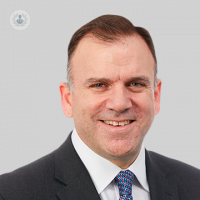Putting your shoulder back in its place
Written by:Our shoulders are incredibly mobile and can carry out a remarkable range of movements – but this mobility also makes them inherently unstable. Leading orthopaedic surgeon Mr Mark Falworth explains why shoulder dislocation occurs, how it is diagnosed and what treatments are available.

Why the shoulder is naturally unstable
The shoulder is the most mobile joint in the body and as such, a complex arrangement of structures is required to stabilise the shoulder during movement. Unfortunately, these structures can be prone to injury and this can influence the stability of the shoulder.
The glenoid (shoulder socket) is a very flat cup, making the shoulder inherently unstable. To deepen the shoulder socket, the glenoid has a rim of fibrous cartilage around its periphery called the labrum.
The labrum is in turn attached to a capsule, which is essentially a sac that helps hold the shoulder on to its socket. Thick condensations of tissue within the capsule make up the ligaments of the shoulder – and it is the continuity of the ligaments, capsule and labrum that help maintain shoulder stability.
How shoulder dislocation happens
If an injury occurs to any of the structures just mentioned, shoulder instability can develop such that the shoulder either partially or completely dislocates.
There are essentially three types of shoulder instability:
- Type I - this occurs following a traumatic injury, such as following a fall or as a result of a sports-related injury
- Type II - occurs in those individuals who are often known to be very flexible or “double jointed”
- Type III - is a more rare form that occurs secondary to abnormal muscle activity
Symptoms of shoulder instability
The symptoms of instability can be very obvious when the shoulder dislocates, even if it only does so partially.
Sometimes, and especially after a number of dislocations, there may just be a sensation of shoulder apprehension or even pain when the arm is elevated and taken out to the side.
Diagnosis
To diagnose shoulder instability, a good history of the symptoms is always helpful, but an investigation, in the form of a MRI scan, is often also necessary.
Treatment options
Treatment is tailored to the nature of the instability and indeed the extent of the soft tissue or bony injuries that have occurred as a result of the dislocations.
As the muscles that support the shoulder (the rotator cuff) are also integral to shoulder stability, physiotherapy is always helpful when trying to address an unstable shoulder.
However, in the presence of a disruption of either the labrum or the shoulder capsule, surgery may still be needed to stabilise the shoulder. This is usually undertaken as an arthroscopic (keyhole) operation following which shoulder stability is restored.
In those cases where a significant injury has also occurred resulting in bony damage to either the glenoid (socket) or the humeral head (ball), then additional bone may have to be surgically fixed to the edge socket to restore stability.
Following any surgery the use of a sling will be necessary for up to six weeks and further physiotherapy support will be needed before one attempts to return to more significant activities such as contact sports.


